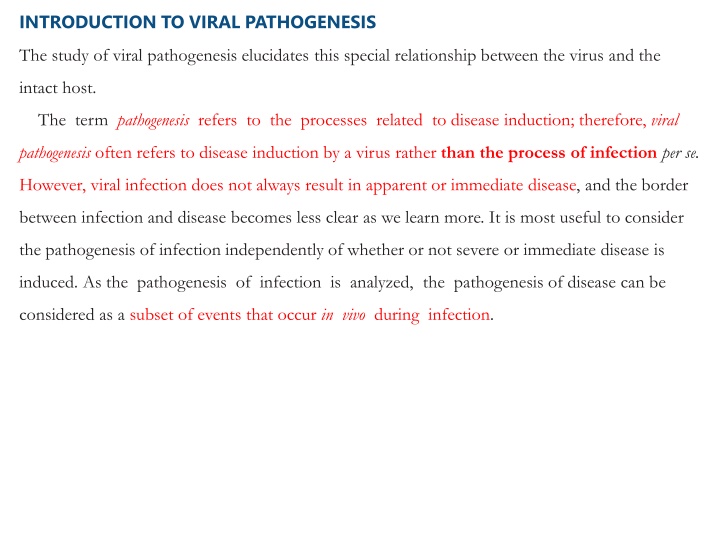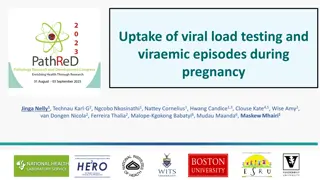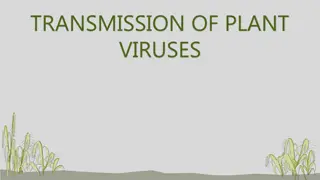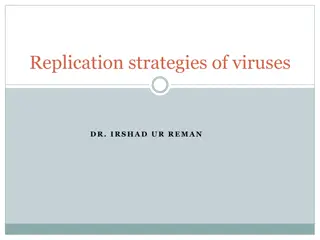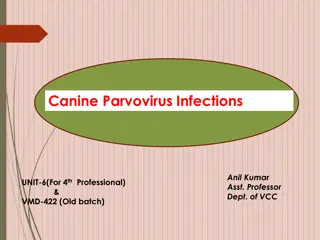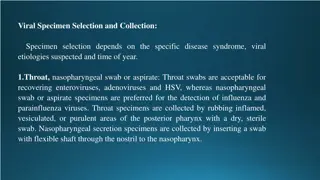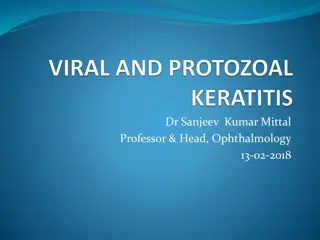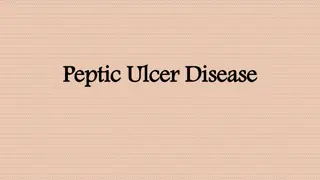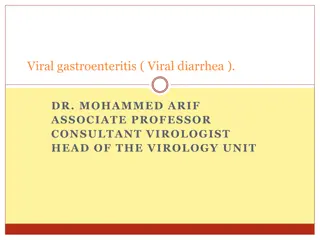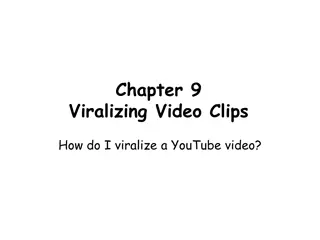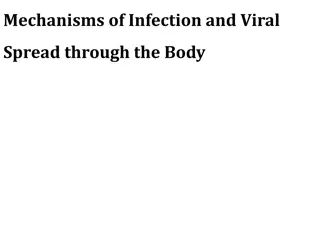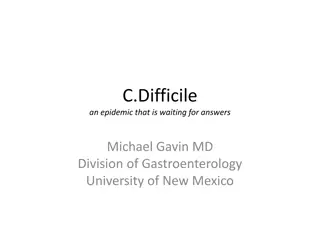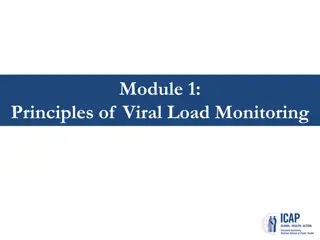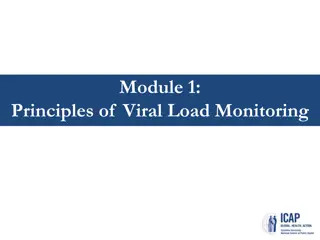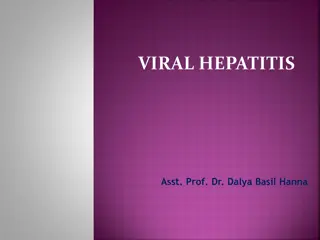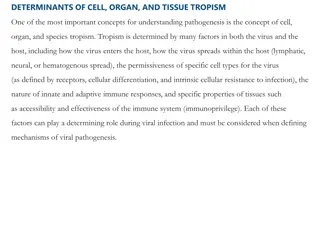Viral Pathogenesis and Infection Dynamics
This content delves into the intricate relationship between viruses and their hosts, exploring viral pathogenesis, infection processes, and the distinction between acute and chronic infections. Understand viral pathogenesis, productive/latent/abortive infections, and mechanisms leading to chronic infection.
Download Presentation

Please find below an Image/Link to download the presentation.
The content on the website is provided AS IS for your information and personal use only. It may not be sold, licensed, or shared on other websites without obtaining consent from the author.If you encounter any issues during the download, it is possible that the publisher has removed the file from their server.
You are allowed to download the files provided on this website for personal or commercial use, subject to the condition that they are used lawfully. All files are the property of their respective owners.
The content on the website is provided AS IS for your information and personal use only. It may not be sold, licensed, or shared on other websites without obtaining consent from the author.
E N D
Presentation Transcript
INTRODUCTIONTOVIRALPATHOGENESIS Thestudyofviralpathogenesis elucidatesthisspecialrelationshipbetweenthevirusandthe intacthost. Thetermpathogenesisreferstotheprocessesrelatedto diseaseinduction;therefore,viral pathogenesisoftenrefersto diseaseinductionbyavirusratherthantheprocessofinfectionperse. However,viralinfectiondoesnotalwaysresultin apparentorimmediatedisease,andtheborder betweeninfectionanddiseasebecomeslessclearaswelearnmore.Itismost usefultoconsider thepathogenesisofinfectionindependently ofwhetherornotsevereorimmediatediseaseis induced.As thepathogenesisofinfectionisanalyzed,thepathogenesis ofdiseasecanbe consideredasasubsetofeventsthatoccur invivoduringinfection.
DEFINITIONSANDCONCEPTSIN VIRALPATHOGENESIS Productive,Abortive,andLatentInfection Infectionistheprocessbywhichavirusintroducesitsgenome into a cell. Infection is productiveif new infectious virus is made andabortiveifnonewinfectiousvirusisproduced. Infection islatentiftheproductionofinfectiousvirusdoesnotoccur immediatelybutthe virusretainsthepotentialtoinitiateproductiveinfectionatalatertime.Theprocessof reinitiatinga productiveinfectioncyclefromthelatentstateistermedreactivation.Latencyisnot merelyaslowproductivereplication cycle;latencyrepresentsauniquetranscriptionaland translationalstatewhereinfectiousvirusisnotpresent,butwherea productivereplicationcycle canbereinitiatedwhentheneed arises.Acellispermissiveifitcansupportproductive infectionandnonpermissiveifinfectioncannotoccuratalloris abortive.
AcuteVersusChronicorPersistentInfection Acuteinfectionoccurswhenavirus firstinfectsasusceptible host(Fig.10.1).Chronicorpersistent infectionisthecontinuationofinfectionbeyondthetimewhentheimmunesystem might reasonablybeexpectedtoclearacuteinfection.Thetermschronicandpersistenthavebeen usedinterchangeablyfor manyyears;wewillcontinuethisconvention.Itisimportant tonote thatthesetermsdenotethepresenceofviralinfection inthehostforlongperiodsbutdonot provideinsightastothe mechanism(s)responsibleforprolongedsurvivalofthevirusin the host.Mechanismsresponsibleforchronicinfectioninclude persistenceofnucleicacid, continuousreplication,latency,and reactivation.Morethanoneoftheseprocessesmayoccur at thesametime.Insomecases,viralnucleicacidcanbedetected inthehostforprolonged periods,althoughthenatureofthe infectiousprocesshasnotbeendefined(seeFig.10.1).In such cases,chronicinfectionmayrepresentcontinuousreplication, latentinfection,abortive infectionwithoutclearanceofresidualnucleicacid,orperhapssomeas-yet-unidentifiedform of viralinfection.
Insomecases,asforHBVorhepatitisCvirus(HCV), aproportionofpersonsbecome chronicallyinfectedwhile othersarecured.Inthesecases,thetransitionfromacuteto chronicis arbitrarilydefinedasthetimewhenmostpatients haveclearedacuteinfection.Inothercases, essentiallyallhosts becomechronicallyinfected,asisseenwithherpesvirusesor lentivirusessuch ashumanimmunodeficiencyvirus(HIV).In thiscase,thetransitionbetweenacuteandchronic infectionis definedasthetimerequiredforclearanceoftheinitialburstof viralreplicationand establishmentofequilibriumbetweenthe hostandthevirus. Therearetwoprimarymechanismsforestablishmentof chronicinfection:continuous replicationandestablishmentof latency.Duringlatentviralinfection,thevirushasagenomic and transcriptionalstrategy,ofteninvolvingrestrictedviral gene expression, which allows the genome to survive even when lyticreplicationisnotoccurring.Examplesincludetheproviral formofretrovirusesorthecircularepisomalformwithselectiveexpressionofviralgenes observedforherpesvirusessuch asEpstein-Barrvirus(EBV)andherpessimplexvirus(HSV). Often,latentlyinfectedcellsexpressnoviralproteins,making latencyimmunologicallysilent. Thisistheultimateformof immuneevasion,asthehosthasnoknownmechanismsfor sensing thepresenceofthevirus.
. Quasispecies Themixtureofvirusespresentinthehostatagiventimeisa quasispecies.Althoughitis convenienttothinkofavirusasa singlehomogeneousagent,thisisnottruebecausebothviral RNA and DNA polymerases make errors that generate mutant virusesduringinfection.The polymerasesofRNAviruses aregenerallylessaccurateincopyingtemplatemolecules thanthoseofDNAviruses;mutationmaythereforeplaya greaterroleinRNAthanDNA viruspathogenesis.However, mutationmayplayaroleinthepathogenesisofanyvirus.
ControlofAcuteVersusChronicInfection Thedistinctionsbetweenacuteandchronicorpersistentinfectionareveryimportant.The viralgenesandhostimmune factorsthatfosterorcontrolacuteversuschronicinfection aredistinct.Forexample,thecytokineinterferon-g(IFNg) regulateslatencyand continuousreplicationofthemurine gHV68(alsoreferredtoasMHV-68)buthasatmosta minimaleffectduringacuteinfection. Thisindicatesthatcertain hostresponsesaremore relevanttochronicthanacuteinfection.Controlofeitheracuteorchronicinfectionmay involve respondingtoviralquasispecies.,itisfundamentallyimportantnottoconsiderchronic infectionasamere continuationofacuteinfection.
EquilibriumandNonequilibrium StatesinPathogenesis Afundamentalconceptinpathogenesisisthatacuteinfectionisanonequilibriumstate, whereaschronicinfectionisa metastableequilibriumbetweenvirusandhost.Duringacute infection,boththehostresponseandvirusinfectionchange continuouslyuntilinfectionis resolvedorprogressestodeath ofthehostorestablishmentofchronicinfection.Incontrast, chronicinfection,onceestablished,isanequilibriumprocess withviralandhostprocesses balancingeachother.Inparticular,theimmunesystemofthehostbringstheacuteinfection undercontrolanddelaysorpreventsachronicinfectionfrom killingthehost.Progressionof chronicinfectiontodisease oftenreflectsachangeinthisequilibrium(seeFig.10.1).
Disease Diseaseisaharmfulpathologicconsequenceofinfection.In manycases,infectionisapparently harmlesstothehostand doesnotresultindisease. Diseasemaybeassociatedwithcellandtissuedestruction (asinrabiesviruskillingneurons), inductionorsecretionof inflammatorycytokines(asintheinductionoffeverbymany viruses), cellulardysfunctioninducedbyviralinfection(asin thecasewithlymphocytic choriomeningitisvirus[LCMV] infectionofthepituitary),paracrineeffectsofviralgene products(asininductionofangiogenesisbyKaposi ssarcomaherpesvirus[KSHV]),andthe inductionofmalignanttumorsto theeffectsoftheimmunesystemasitrespondstoinfection(as inimmunopathologyseenwithmanyviruses)ortothepresenceofaspecificvirusinteracting withallelicpolymorphisms inthehosttotriggerdisease.
Virulence Virulence therelativecapacityofavirustocausedisease determinestherelationship betweeninfectionanddisease.Virulentvirusescausediseaseinagreaterproportionofinfected hosts,andcausemoreseveredisease,thanvirusesoflowervirulence.Themanifestationsof virulencehighlydependonthestrategiesthatagivenvirususes duringinfection. virulenceisproperlyusedtocompare thedisease-inducingcapacityofrelatedviruses,such asdifferentstrainsofthesamevirus.Forexample,EbolaReston,which isnotassociatedwith humandisease,islessvirulentinhumans thanEbolaZaire.Otheraspectsofpathogenesis, includingtropism, thehostresponsetoinfection,andinteractionsbetweenthe virusandhost tissues,playkeyrolesinviralvirulence.
Invasiveness Invasivenessisthecapacityofavirustoenterintoanddamage atissue,apropertythat distinguishesviruseswithhighpotentialvirulencebutdifferintheefficiencywithwhichthey enter targettissues.Forexample,avirusmaybehighlyvirulentif directlyinoculatedintothe centralnervoussystem(CNS)but unable to cause disease if inoculated into the periphery, whereas arelatedviruswithamutationallowingittocrosstheblood brainbarrierintotheCNS cancauselethaldiseasefollowing eitherperipheralorintracranialinoculation. Cell-IntrinsicVersusCell-ExtrinsicMechanisms Eventsthatoccur inacellindependentofeventsoutsideoftheinfectedcell aretermed cellintrinsic.Somecell-intrinsicdeterminantsof infectionareowingtointrinsiccellular resistancetoinfection conferredbythepresenceofmoleculesthatblockviralinfection.Events thataredictatedbyprocessesthatoccuroutside ofthecellaretermedcellextrinsic.Manycell- extrinsicevents areowingtoinnateandadaptiveimmunity.Itisoftenthe casethat processesoccurringininfectedcellsortissuesare affectedbybothcell-intrinsicandcell- extrinsicmechanisms.
EvasionofHostMoleculesandMechanisms Mostviruseshaveevolvedmechanismstocounterhostinnate andadaptiveimmunityorto bypassintrinsiccellularresistancemoleculessothattheviruscancompletetheinfectious processandspreadtoanewhost.Thesemechanismsconstituteviralevasionofhostresponses. Often,evasionstrategies involveviralgeneswithclosehomologytohostgenes,aswhen avirusencodesahostcytokineorcytokinereceptormimic. Otherevasionstrategiesutilizemoleculeswithnovelstructures toavoidhostresponses. Becausethemechanismsresponsible foracuteandchronicinfectiondiffer,bothwithregardto viral andhostfactors,itfollowsthatimmuneevasionmechanisms aredifferentforacute versuschronicinfection.Duringacute infection,viralimmuneevasionstrategiescommonly focuson thehostinnateimmuneresponse,whereasevasionofadaptive immunity is more important for maintaining chronic infection.
Tropism Tropismisthecapacityofavirustoinfectordamagespecific cells,tissues,orspecies.Itisa fundamentallyimportantcontributortoviralpathogenesisandvirulence,asthecapacity toinducediseasedependsonthecellandtissueinfected.For example,aneurotropicvirussuch asWestNileViruscancause encephalitis or paralysis, whereasaviruswithtropismforCD4T cellssuchasHIVcausesimmunodeficiency. Onekeydeterminantofviraltropismisthecognate interactionbetweentheviralcell attachmentprotein(s)and receptor(s)present on host cells. EssentialGenes,VirulenceGenes, andVirulenceDeterminants Anygeneessentialforreplicationcontributestovirulence, becausevirusesmustreplicateto completetheirlifecycle.In thissense,allviralgenesinvolvedinreplicationarevirulence genes.Asthisisnotaveryusefulconcept,viralgenesessentialforreplicationinpermissivecells aretermedessentialgenes ratherthanvirulencegenes.Virulencegenesarenotrequired forreplicationpersebutareimportantforvirulence
ConceptualizingViralPathogenesisasaSeries ofSequentialStagesinInfection Polioviruspathogenesisprovidesanexcellentexampleof howpathogenesiscanbebroken downintoaseriesofsteps thatculminateineithervirus-induceddiseaseorviralcontrol. Infectionwithpoliovirusinhumanshasawiderangeofpossibleoutcomesfromasymptomatic infectiontomeningoencephalitiswithorwithoutparalysis. Studiesovermanyyearsidentifiedandanalyzedaseries ofstagesofpoliovirusinfection, leadingtoarelativelysimple modelforthepathogenesisofdiseasethatelegantlyexplains paralysis,thelowproportionofinfectedhostsparalyzed, andthelifelongimmunity conferredbypriorinfection.This model,oneofthemostusefuleverconstructed, provideda basisfordevelopingthepoliovirusvaccinesthathavelargely, althoughnot completely,eliminatedparalyticpoliomyelitisas ascourgeofhumanity. Thestagesinpolioviruspathogenesisaccordingtothis modelareoutlinedinFigure 10.2
importantanatomicbarriertoinfectionoftheCNS,andpassageacrossthisbarrierispoorlyimportantanatomicbarriertoinfectionoftheCNS,andpassageacrossthisbarrierispoorly understood.Alternatively,the virusmayspreadviathebloodtoperipheralnervesandthen spreadupthenervestoentertheCNS.Within theCNS,thevirusinfectsmotorneurons; destructionofthese cellsleadstoparalysis.Certainmotorneuronsarehypothesized tomoresusceptibletopoliovirusinfectionthanothers,and somepoliovirusstrainsareeithermore invasiveormorelikely tokillneuronsthanothers;thesevariablescontributetovariationindisease penetranceandseverity. Concurrentwithentryintothelymphaticsystem,an immuneresponseisgenerated(seeFig. 10.2).Itishypothesizedinthismodelthatimmuneantibodylimitsaccessto theCNSandprevents paralyticdisease.Antibodymight actbypreventingvirusinthecirculationfromcrossingthe blood brainbarrierandenteringtheCNS.However,antibodyiscapableofinhibitingneural spreadofvirusesandcan inhibitviralinfectionbyactingdirectlyonorwithinneurons.
Regardlessofthemechanismsbywhich antibodyprotects,theoutcomeofinfectionisa racebetween thevirusandtheimmunesystem,presentinganotherexplanationforvariations inclinicaloutcome.Theimmunesystem winsifantibodyismadeearlyenoughtoprevent spreadtothe CNSandneuronaldestruction.Theviruswinsifinfection ofmotorneuronsoccurspriortodevelopmentofprotective antibodyresponses. Thismodelprovidesabasisforunderstandingmany aspectsofpoliovirusinfection, disease,immunity,andvaccination;
ConceptualizingViralPathogenesisasthe IntegratedEffectsofHostGenetic Variation Themajorhost determinantofviralvirulenceandpathogenesisisinnateand adaptiveimmunity, buthostgenesnotinvolvedimmunityalso playarole.Allelicvariationsinthesehostgenescan alterviral pathogenesis(Fig.10.5). - MutationsinCCR5 conferresistancetoHIVinfection. - Humannoroviruses (typevirusNorwalk)areresponsibleformorethan90%of theepidemic nonbacterialgastroenteritisintheworld.Norwalkvirussusceptibilityisdeterminedby bloodgroup secretorstatusconferredbythepresenceoftheFUT2fucosyltransferase.
Amonghumannorovirusstrains,thereare multiplepatternsofvirus-likeparticle(VLP)binding toblood groupcarbohydrates,suggestingthatallelicvariationinhuman bloodgroupscontribute tosusceptibilitytoavarietyofnorovirusstrains. -PatientswithmutationsintheIFNgreceptorhave beenreportedtohaveunusualviral syndromes. - Autosomal dominantmutationsinthechemokinereceptorCXCR4have beenassociatedwith severewarts,andmutationsinEVER1 andEVER2havebeenassociatedwithanunusual clinicalpresentationofpapillomavirusinfectioncalledepidermodysplasia verruciformis. - Allelicvariationsinmannose-bindinglectin andFcgRIIAhavebeenlinkedtotheseverityof severeacute respiratorysyndrome(SARS). -- Arelationshipbetween expressionofcertainKIRgenes,encodingNKcellreceptors,and severityandchronicityofinfectionwithHIV,HCV, andEBVhavebeenreported.
Epidemiology Epidemiologyisanessentialtoolforpathogenesisresearchfor defining patterns of disease and infection and the mode of transmissionbetweenhosts. Togetherwithassaysforpriorinfection suchasserologyormoleculardetectionofchronicvirusinfection,epidemiologycandefinethe relationshipbetweeninfection,immunity,anddisease.Epidemiologicstudieslinkavirus toaspecificdiseaseandallowformulationofthefundamental questionsthatmustbeanswered tounderstandviralpathogenesis.
ThisisnicelyillustratedbytheidentificationofKaposis sarcoma(KS)herpesvirus,where epidemiologystudiessuggestedthatHIVstatusalonewasnotanaccuratepredictorof KSrisk,indicatingthatanadditionalco-factorwasresponsible forKS.Followingthediscovery ofKSHV,additionalepidemiologicinvestigationsconvincinglylinkedKSHVinfection withKSviademonstrationthatKSHVsequenceswerepresent almostuniversallyinKS lesionsandthatseroconversionto KSHVprecededthedevelopmentofKS.
Therearetwotypesofanimalmodelsforhumanviral disease.Inthe first,onestudiesahuman virusininfectedanimals.Inthesecond,onestudiesananimalvirusthatisrelated toahuman virusinitsanimalhost.Thereisanessentialtensionbetweenthesetwoapproaches;inonethe real pathogen isstudied,andintheothera natural infectionisstudied.In truth,eachhasits advantagesandeachitslimitations. StudyofHumanVirusesinAnimalModels Humanvirusescanbestudiedinanimalsthataresusceptibleto infectioneitherbecausethe virusdoesnotexhibitspeciestropismorbecausetropismrestrictionsareovercomeviagenetic manipulationofthehostorvirus. Excellentexamplesofthisapproacharetheanalysisof infectionwith filovirusessuchas EbolaorMarburgthatare verydifficulttostudyininfectedpatients.However,these virusescausediseaseinmacaqueswithsignificantsimilarities tohumandisease,includinga strikinghemorrhagicdiathesis includingdisseminatedintravascularcoagulation.These animalmodelshavebeenusedtodemonstratethatitispossible tovaccinateagainst filovirus infectionandthatpassive transferofantibodycanbepartiallyprotective.
Notallhumanvirusescanreplicateinanimals.Five approacheshavebeentakento overcomethishurdle.These approachesare, -First,passage-basedadaptationofthehuman virustogrowthinanexperimentalanimal; - second,engineering ofthehosttoaccommodateallorpartofthepathogenesisof thehumaninfection; -third,expressingthevirusasatransgene inanexperimentalanimal; -fourth,thecreationofhumanizedmicewhereimmunodeficientmicearereconstitutedwith aspectsofthehumanimmunesystemandcomponentsofthe humantargetorgan(e.g.,theliver forHCV);and -Fifth,targetedmodificationofvirusestoallowreplicationinamodel host.
1.Inthe firstapproach,ahumanvirusisadaptedtogrowthinananimalmodel.Ebolahas adaptedtoinfectguineapigsandmice.Ebolainfectionofsmallanimalsissimilar toprimateand humanEbolainfectionsinsomeways.Forexample,dendriticcells(DCs)andmonocytesare earlytargetsofinfectioninallofthedifferentmodels.However, miceandguineapigsdonot showthehemorrhagicdiathesisseeninhumansandmacaques,whichisasignificant limitationforpathogenesisstudies. 2.Inthesecondapproach,thehostisgeneticallyengineeredtoallowanalysisofahumanvirus. Forexample,transgenicexpressionofthepoliovirusormeaslesvirusreceptorsin miceconfers susceptibilitytointracerebralinfectionwithpoliovirusormeaslesvirus. 3.Inthethirdapproach,thevirusisexpressedasatransgene inaliveanimal,allowingthe replicationcycleofthevirustoproceedincertaincellseventhoughthehostisnonpermissive forinfection. ThishasbeenaccomplishedforHBVwithmiceengineeredtogenerateinfectious virusfromatransgenicviralgenome.
4.Inthefourthapproach,miceareusedashostsforhumantissueallograftsthatcanthen4.Inthefourthapproach,miceareusedashostsforhumantissueallograftsthatcanthen beinfectedwithhumanviruses.Thisapproachisparticularlyusefulforvirusesthat failtoreplicateinnonhumansystemsandhasbeenapplied tovirusessuchasHIVandVZV. 5.Inthe fifthapproach,thevirusismanipulatedinaspecificwaytoallowinfectionofthe animaltobeusedasamodel. Forexample,basedonanintimateknowledgeofthemechanismsoflentivirusspecies tropism,ithasbeenpossiblevia manipulationoftheHIVvifgenetocreateanHIVisolate thatcanreplicateinmacaques
. CellCulture Cellcultureisanessentialtoolforthestudyofviralreplicationandtropism.However, conditionsincellculturearenot representativeofconditionsinvivo,andthushypothesesfrom cellcultureexperimentsmustbevalidatedinvivo.Oneobviouslimitationtocellculturestudies istheabsenceofacellular immuneresponse.Thereareadditionalimportantlimitations tocellculturestudies.Often,asmallproportionofcellsina tissueareactuallyinfectedata giventime,whereascellculture isoftenoptimizedforsynchronizedinfectionofallcells.This obviateseffectsofinfectedcellsonas-yet-uninfectedcells a fundamentallyimportantpartof whathappensintissues
.For example,interferonreleasedfromoneinfectedcellcanprotectuninfectedcellsfromviral infection.Asinterferoneffects generallyrequireinductionofgeneexpression,pretreatmentof cellsin cultureis usuallyrequired toseefulleffects ofinterferon onviralinfection,effectsthat arelostifallcellsaresimultaneouslyinfected.Furthermore,culturedcellsareoftentransformed orcontinuouslineswhosebehaviorisatmostdistantly relatedtothebehaviorofprimarycells. Evenwhenprimary cellsareusedintissueculture,itisunlikelythatthebiologyof thesecellsis thesameasthebiologyofcellsresidinginatissue incontactwithphysiologicextracellular matrix,thecirculatory system,theendocrinesystem,andotherprimarycells.
